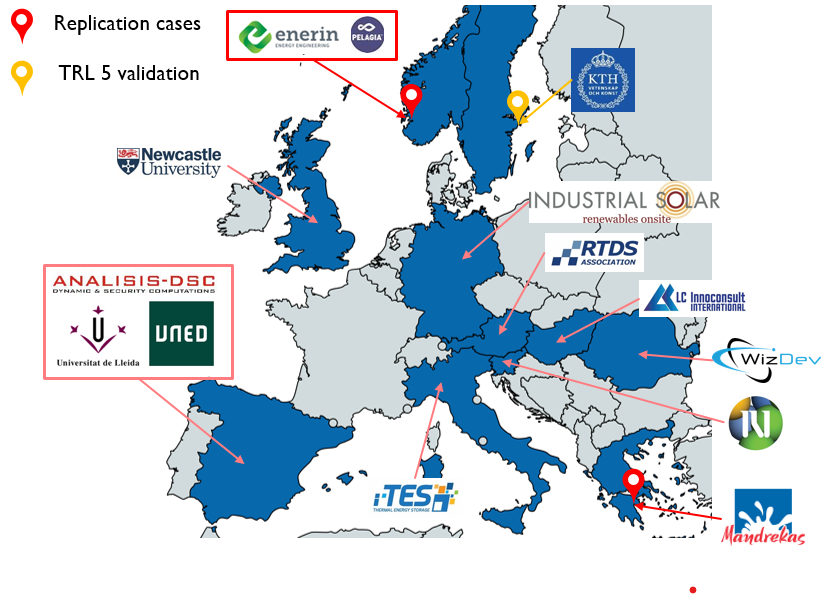SUSHEAT — Smart Integration of Waste and Renewable Energy for Sustainable Heat Upgrade in the Industry
SUSHEAT faces the main technological challenges to address the development of the key components for a new generation of highly efficient industrial heat upgrade systems fed by Renewable Energy Sources (RES) and waste heat recuperation. SUSHEAT technologies will explore renewable-based flexible and reliable heating solutions to power industrial processes. This will enable industry to transition away from polluting carbon-intensive fuels that dominate the energy mix. New and existing AI-assisted systems will be explored for optimal heat harvest, conversion and upgrade, and storage.

Background
Industrial processes require large amounts of heat currently generated by fossil fuels that account for more than 20% of world energy use and carbon dioxide (CO2) emissions. The United Nations International Panel on Climate Change stipulates that by 2030 global CO2 emissions need to be reduced by 45% compared to 2010 levels. The big industrial energy challenge is to address the current, intermittent energy source availability from renewables. An innovation leap is required to deliver reliable, flexible renewable heat upgrade systems for heat on demand, at the right temperature and price for factory processing needs. A critical, global target is to develop thermal heat systems for energy storage that are suitable for many factory settings with less greenhouse gas emissions.
SUSHEAT introduces a rational concept to harvest energy from renewable sources and waste heat to replace fossil energy for industry. SUSHEAT solutions aim to ease the immediate and future supply impacts of industrial heat electrification on the local grid.
Aim and Objectives
The main goals and objective of SUSHEAT is to contribute to the reduction of carbon dioxide (CO2) emissions in industrial processes by replacing fossil fuels with flexible and reliable renewable-based heating solutions. To achieve that the project will:
- Develop and validate an efficient, heat temperature upgrade (150-250°C) using a Stirling-based high-temperature heat pump working with low-global-impact-potential fluids to achieve the target high-temperature heat upgrade.
- Develop and validate a bio-inspired highly efficient Thermal Energy Storage system using a Phase Change Material that is adaptable to the heat requirements at target temperatures which can provide system flexibility.
- Develop and validate a digital twin smart Control and Integration Twin system based on AI, machine learning, and big analytics.
- Validate the integrated RES based heat upgrade system under relevant working conditions.
Project partners
-
UNIVERSIDAD NACIONAL DE EDUCACION A DISTANCIA
-
KUNGLIGA TEKNISKA HOEGSKOLAN
-
ENERIN AS
-
UNIVERSIDAD DE LLEIDA
-
WIZ DEVELOPMENT & SERVICES SRL
-
DYNAMIC & SECURITY COMPUTATIONS SL
-
RTDS - VEREIN ZUR FORDERUNG DER KOMMUNIKATION UND VERMITTLUNG VON FORSCHUNG, TECHNOLOGIE UND INNOVATION
-
INDUSTRIAL SOLAR GMBH
-
LASER CONSULT MUSZAKI-TUDOMANYOS ES GAZDASAGI TANACSADO KORLATOLT FELELOSSEGU TARSASAG
-
I-TES SRL
-
KEMIJSKI INSTITUT
-
GALAKTOKOMIKA MANDREKAS ANONYMI ETAIREIA
-
PELAGIA AS
-
NEWCASTLE UNIVERSITY
Funding is provided by Horizon Europe (CINEA) - Grant Agreement No 101103552
Timeframe: May 2023 – April 2027
Project website: HOME | SUSHEAT

Publications
Innovation trends on high-temperature thermal energy storage to defossilize energy systems
Researchers
References
List of references already enumerated as appear in the project webpage description.
